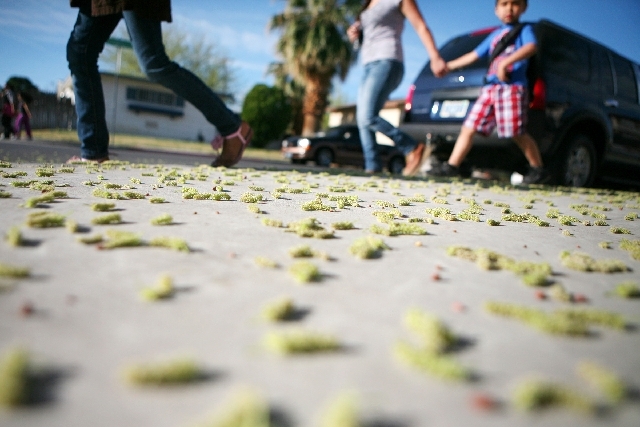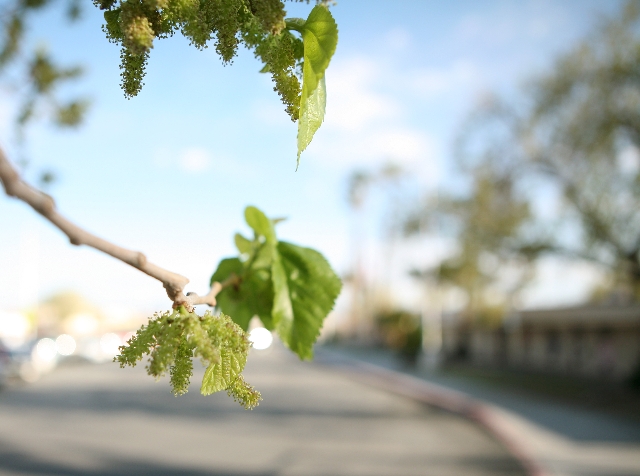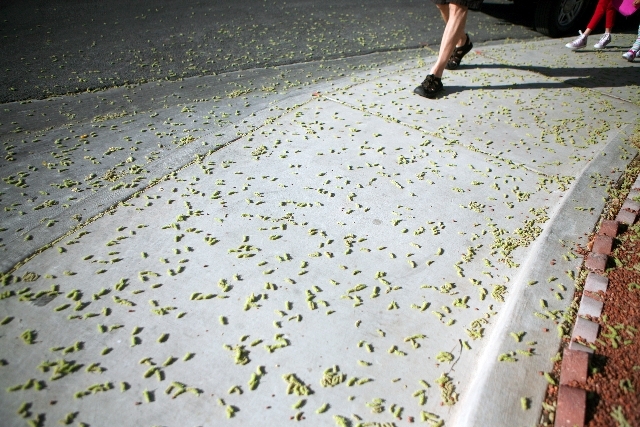Grab a tissue: It’s pollen season in Clark County
If your body is rejecting spring like a mismatched kidney right now, you’re certainly not alone.
According to experts, up to one quarter of valley residents suffer from seasonal allergies, and that season of sniffling, scratching misery is well under way.
The prime culprit at the moment is a tree so noxious it’s actually illegal in Clark County: the dreaded fruitless mulberry.
In older neighborhoods, where planting predates the county’s 1991 ban, mulberry trees are covered in yellow-green tassels, and everything around them is coated in a fine layer of pollen.
But Dr. Joram Seggev doesn’t need to go outside to know what plants are in bloom. All it takes is a glance at his waiting room.
The longtime Las Vegas allergist said he usually sees a 30 percent to 70 percent increase in patient volume as pollen levels peak.
At the moment, his appointment book is filled to overflowing with old patients who have been avoiding him since last year and new patients, some of whom were told when they moved here that “in the desert they will have less allergies,” Seggev said.
The pollen season generally starts in February and lasts until the summer heat arrives in June, though it can be shorter or longer depending on the weather.
When the mulberry pollen dissipates in the next few weeks, it will be replaced by olive pollen, an even more potent allergen.
Seggev said typical reactions include itchy eyes and skin, runny nose, sneezing, dry cough and fatigue.
Left untreated, such symptoms can lead to sleeplessness, infections, asthma, missed work, lost productivity and, in rare cases, even depression.
“There’s a real economic advantage to having properly controlled allergies,” Seggev said.
The fruitless mulberry does have its defenders.
Norm Schilling is president of the landscape contracting firm Schilling Horticulture Group and the passionate, plant-loving voice behind many of the “Desert Bloom” gardening segments featured on local public radio station KNPR.
Schilling thinks the mulberry has a bum rap, though he admits he doesn’t have to dread the arrival of spring the way some valley residents do.
“I’m blessed that I’m not allergic to plant pollen in my line of work,” he said.
The mulberry found favor among Las Vegas landscapers starting in the 1950s because it grows quickly, provides ample shade and stands up well to hot weather and overzealous pruners.
Most of the trees that were planted are male, which don’t produce messy fruit like the female trees, but do churn out pollen in thick, irritating clouds.
“It was probably the No. 1 planted tree for two or three decades,” Schilling said. “Now they are big stately trees. They’re still a big part of the urban forest.”
But their days appear to be numbered. Thanks to the county’s ban, which echoed similar restrictions in other Western cities, there might not be many fruitless mulberries left after the older trees die off in a few decades.
The good news, Schilling said, is that the ban on mulberry and all European varieties of the olive helped pave the way for a greater variety of shade trees to take root here.
But he also thinks mulberry and olive trees were “scape-goated” among pollen producers. By removing them, he said, officials only managed to take “a few thimble-fulls (of pollen) out of the bucket.”
Clark County used to monitor airborne pollen levels and issue daily reports to the public, but the effort was discontinued in 2010, when it lost its funding and its lead technician to retirement.
“It was a very popular program,” said Lewis Wallenmeyer, director of the county’s Department of Air Quality, but it was also a “luxury” because pollen monitoring is not required under state and federal environmental rules.
Now there is a push to bring back the pollen count, perhaps in time for next year’s allergy season.
According to spokeswoman Amanda Fulkerson, the Clark County School District plans to team with UNLV on at least one monitoring station at the university’s main campus. She said the station could be paid for with money from an air quality education fund that takes in a portion of the fines paid by those who violate clean air regulations.
Seggev said he also hopes to play role in bringing back the monitoring program, which is important to people with allergies and of scientific interest to researchers studying pollen, air quality and human health.
Wallenmeyer, for one, will welcome the return of the pollen report, though he doesn’t need any scientific equipment to tell him when the mulberry and olive trees bloom each year.
“I know when both of them hit personally,” he said.
Contact reporter Henry Brean at hbrean@reviewjournal.com or 702-383-0350.
TIPS TO EASE YOUR PAIN
Seasonal allergies can be miserable, but Dr. Joram Seggev, a long-time Las Vegas allergist, and others have a few tips to ease your pollen problems.
-- Keep the windows closed on your house and car. Run the air conditioner in recirculation mode.
-- If you have to go out, wear a mask over your nose and mouth and "engulfing" sunglasses to protect your eyes from irritants.
-- Shower and wash your hair before you go to bed at night. Rinse your nose with saline solution.
-- Change your clothes and keep your unwashed laundry away from where you sleep.
-- Keep your pet indoors as much as possible and don’t let it on your bed after it has been outside.
-- For most people, allergy symptoms are worst in the morning, so take long-lasting allergy medication before you go to bed at night so you are protected when you awake.




















